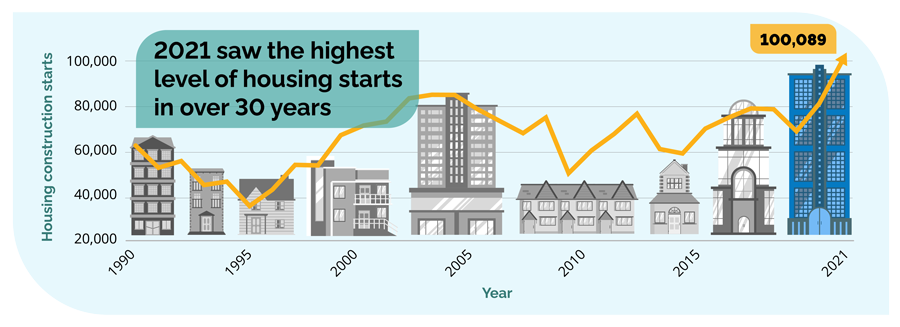Note: More Homes for Everyone Act received Royal Assent on April 14, 2022.
Overview
Ontario is the best place to live, start a business and raise a family — but we can only build on our success if all Ontarians and their families are able to find the home that’s right for them.
As Ontario’s population continues to grow, the province is building the housing, health care and highways we need to build a brighter future for everyone.
The province’s housing policies are working to get more homes built faster, but too many Ontarians still struggle to find a home.
Chart: Housing starts in Ontario from 1990–2021

Chart description: Line graph of housing starts from 1990, showing that 2021 had the highest level of housing starts in over 30 years.
Source: Canada Mortgage and Housing Corporation Starts and Completions Survey
We held a three-part consultation with the public, municipalities and industry:
- An online public consultation where we received over 2,000 submissions.
- Consultations and discussions with municipalities and municipal associations via:
- the Ontario-Municipal Housing Summit and Rural Housing Roundtable where we consulted with municipalities large and small
- the 2022 Rural Ontario Municipalities Association (ROMA) conference
- meetings with municipal associations including ROMA, the Association of Municipalities of Ontario (AMO) the Mayors and Regional Chairs of Ontario (MARCO) and Ontario’s Big City Mayors (OBCM)
- The Housing Affordability Task Force which consulted with municipalities, experts and industry.
We also conducted Lean engagement on housing approvals processes, supported by the province’s Lean Office, with nine municipalities and exchanged letters with municipalities to gather further feedback and input.
More Homes for Everyone proposes targeted policies for the immediate term that make housing fairer for hardworking Ontarians and make it faster to build the homes that families need and deserve.
The commitment
We heard from municipalities that they aren’t ready to implement ambitious policies from the Task Force’s report right now. For example, we have introduced policies at the provincial level that have not been fully implemented at the local level, such as the additional residential units framework and community benefits charges framework.
Addressing the housing supply crisis is a long-term strategy that requires long-term commitment and partnership at all levels of government.
The Task Force report is our long-term housing roadmap. Similar to Ontario’s approach with regular Red Tape Reduction bills, the province is committed to implementing the Task Force’s recommendations with a housing supply action plan every year over four years, starting in 2022–2023, with policies and tools that support multi-generational homes and missing middle housing.
To ensure municipalities actively support these policies, we are establishing a Housing Supply Working Group which will engage with the federal and municipal governments, partner ministries, industry and associations to monitor progress and support improvements to our annual housing supply action plans.
Key next steps
To start this cycle of continuous improvement, we have launched a series of topic-specific public consultations which can be found on the Environmental Registry of Ontario. Key examples include:
- Housing needs in rural and northern municipalities — seeking input on ideas to address the unique housing needs for rural and northern Ontario municipalities
- Increasing missing middle housing, including supports for multigenerational housing — seeking input on how to diversify housing choices in existing neighbourhoods
- Illegal new home building — seeking input on ways to address illegal home building, where a builder/vendor does not have a license to build/sell new homes and/or does not enroll the home with Tarion
- Access to financing for not-for-profit housing developers — seeking input on the barriers faced by not-for-profit developers and providers and how to make it easier for not-for-profit housing providers to build and repair housing
Less red tape, more homes
Support timely municipal decision-making

An Ontario Association of Architects study calculating the cost of delays between site plan application and approval concluded that for a 100-unit condominium apartment building, each additional month of delay costs an estimated $1,930 a month for each unit. As stated in the Task Force’s report, “One of the strongest signs that our approval process is not working: of 35 OECD countries, only the Slovak Republic takes longer than Canada to approve a building project.”
We invested up to $350 million to help municipalities across the province make their planning and approvals processes more efficient to identify potential savings, accelerate the creation of new housing and modernize municipal services, through three programs:
- the Streamline Development Approval Fund
- the Audit and Accountability Fund
- the Municipal Modernization Program
This funding will help municipalities streamline and modernize their planning approval processes including official plan amendments, and rezoning, plan of subdivision and site plan applications.
Our plan would incentivize municipalities to make timely decisions within realistic timelines.
To get the politics out of planning, while continuing to ensure the objectives of site plan control are fully met, our plan would require council to delegate site plan control decisions to municipal staff, typically professional planners who have the professional expertise to evaluate the issues, understand the technical planning matters and approve the drawings and plans in a timely manner.
To help municipalities meet realistic timelines, we also propose to extend the timeline for municipalities to review site plan applications before appeals can be launched from 30 days to 60 days.
Plans of subdivision requirements aren't standardized and can vary considerably between municipalities leading to longer timelines, increased costs, redundancies and scope creep. Our plan would allow the province to propose what can be required as a condition of draft approval for subdivision plans. It would also give municipalities a one-time discretionary authority to reinstate draft approved plans of subdivision that have lapsed within the past five years without a new application to streamline decision-making. This would only be allowed where units have not been pre-sold.
Applicants who do not receive approval of their site plan application within the legislated timeframe would have their application fees refunded through a phased approach. Fees would be refunded at the following percentages based on the amount of time that has passed since the municipality received the complete application and fee, starting January 1, 2023:
- 50% of the fee within 60 days
- 25% of the fee within 90 days (for a total refund of 75%)
- 25% of the fee within 120 days (for a total refund of 100%)
We would also require municipalities to partially refund zoning by-law amendment fees if they fail to make a decision on an application within 90 days (or 120 days if the decision is concurrent with an official plan amendment application) from the date the municipality received the complete application and fee, starting January 1, 2023. There would be a graduated approach to eventually fully refunding the fee.
Community Infrastructure and Housing Accelerator
In response to requests from municipalities, we are introducing a new tool to help municipalities accelerate their own planning process – the Community Infrastructure and Housing Accelerator. It would help municipalities speed up approvals for housing and community infrastructure, like hospitals and community centres, while increasing transparency and accountability. The Community Infrastructure and Housing Accelerator could not be used in the Greenbelt, maintaining our steadfast commitment to protecting this valued area.
To use this tool, municipalities would need a council resolution and a formal request explaining the project rationale, the approvals sought and any consultations.
This tool would:
- empower local communities and break down silos by removing barriers and accelerating downstream approvals at the request of the municipality
- focus on specific types of projects such as community housing, market housing or long-term care
- strengthen accountability by requiring municipalities to consult with the public including publishing a public notice for these meetings, before a Community Infrastructure and Housing Accelerator request is submitted to the Minister of Municipal Affairs and Housing
- enhance transparency by requiring the municipality’s request and the final Community Infrastructure and Housing Accelerator order be available to the public
- allow the minister to impose conditions on Community Infrastructure and Housing Accelerator orders to help mitigate potential negative impacts to ensure outcomes meet expectations that the projects are delivered in a timely manner
Streamlined, faster process to enable innovation
Changes to the Building Code will:
- allow 12-storey mass timber buildings
- streamline modular multi-unit residential building approvals
- facilitate more infill and low rise multi-unit housing by exploring opportunities to allow for single means of egress in four to six storey residential buildings, while continuing to protect public health and safety
- explore safe ways to allow residents and commercial tenants of the lower floors of super-tall buildings under construction to move into their units earlier, so they can find a home and open the doors of their business sooner
We are also working with the municipal sector to address the shortage of building officials and inspectors by making it simpler and faster to take the qualification exams and empowering chief building officials to develop internship programs, reducing unnecessary construction delays and providing Ontario with the labour workforce we need to build new homes.
We propose to require municipalities to make reports on development charges available to the public – such as by posting them to their website. Many municipalities already do so, but this would increase standardization across the sector. It would also increase transparency and make sure the public can better understand charges that municipalities levy on new homes, and how fees paid by new development help fund local infrastructure, services and facilities that benefit the entire community.
According to a 2020 BILD study, development charges can average about 10% of housing prices.
To further enhance transparency, we are also proposing that municipalities review their community benefits charge bylaws at least once every five years. This would ensure that the community benefit charge levied would more accurately reflect the changing growth-related infrastructure costs of the municipality.
Building complete communities requires careful planning for not just housing, but employment uses, infrastructure and transit. We are implementing our Transit-Oriented Communities Program, which provides real opportunities to build vibrant, higher density, mixed-use communities that are connected to transit stations.
For transit-oriented communities, we propose to set a maximum for the portion of a home builder’s development land, or cash-in-lieu, that a municipality can use for parks. These changes would:
- balance the priority for new housing close to transit
- help more Ontarians be less dependent on cars
- continue to create more parks
When home builders start a project, they may be obligated to provide assurance that the required infrastructure to support those homes, like sidewalks, will be constructed as well. This assurance is commonly provided through a letter of credit or cash. We are establishing regulation-making authority that would enable home builders to leverage surety bonds for this purpose. Wider acceptance of surety bonds could help free up money for home builders to pursue additional home building projects and make some projects that currently can’t obtain financing more viable. A future regulation would maintain the municipal ability to obtain the financial security they need to secure the land-use developer obligations in municipal agreements.
Improve data collection to make informed decisions with our partners
Good data forms the foundation of good planning decisions and enables us to measure our progress over time in closing the gap between housing supply and demand.
How that information is captured, shared and used varies between ministries and across the province. We don’t have the data we need and we should share what we have regularly so municipalities can base their growth planning on the most up-to-date forecasts.
Proposed Planning Act amendments would provide more transparency by establishing authority to require public reporting by planning authorities on development applications that have been submitted, are complete, under review and approved (for example, zoning, plans of subdivision, site plan) and the use of a data standard.
To help inform municipalities of current and projected population growth, we’re going to share the Ministry of Finance’s annual population projections with municipalities and focus on the main drivers of the population growth of Ontario’s census divisions, such as immigration and intra-provincial migration. This will help them plan more accurately and intelligently to meet their short and long-term housing needs.
As part of our work to build a world-leading digital economy, we’re partnering with municipalities and industry to build a provincial data standard for planning and development applications. While some larger municipalities have moved to electronic tracking and e-permitting, many smaller municipalities are struggling to adopt similar digital processes. A development approvals data standard would also support consistency and standardization to facilitate data sharing, reporting and e-permitting across the province.
Our plan also includes connecting transit ridership forecasts to the growth of residential housing and employment, which will help ensure municipal transit and infrastructure policies are aligned.
Investing in and empowering the Ontario Land Tribunal
The Ontario Land Tribunal (OLT) plays an important role in Ontario’s housing sector as an impartial adjudicator to resolve proposed housing development disputes and break the cycle of delays and appeals. Our investment of more than $19 million over three years will help both the OLT and the Landlord and Tenant Board to reduce their backlogs. The funding will enable the tribunals to hire more staff, including adjudicators who provide impartial third-party decision-making, so land use planning and tenant and landlord disputes can be resolved faster. Funding will also support the OLT to expand technology to further enhance efficiency and e-services.
As municipalities plan for housing and other community infrastructure to accommodate Ontario’s growing population, it’s critical to address the politicization of the planning process. This is because it can lead to delays in getting housing built, which holds back supply and drives up home prices.
To help depoliticize planning decisions and get housing built faster, and support municipalities to respond to provincial changes (including on data collection and use) we are proposing changes to the Planning Act. These changes would empower the OLT by enabling the Minister of Municipal Affairs and Housing, when making decisions on official plans and amendments, to refer all or parts of an Official Plan matter to the OLT for a recommendation, or the entire matter could be referred to the OLT to make a decision as an impartial adjudicator.
The minister would also be able to pause the 120-day decision-making clock that determines when certain Official Plans or Official Plan Amendments that are before the minister can be appealed for a non-decision. These proposed changes are designed to encourage dispute resolution, ensure consistency in how planning policies are implemented and avoid further delays from appeals while continuing to support thoughtfully designed and livable communities.
Build where it makes sense while protecting the Greenbelt
Growing the Greenbelt is an important part of the government’s balanced, forward-thinking strategy to build a stronger Ontario.
That’s why we’ve launched a second phase of Growing the Greenbelt consultations and are engaging with Indigenous communities to seek feedback on adding proposed urban river valleys to the Greenbelt. We intend to expand existing and/or create new urban river valleys in 13 locations to protect 940 hectares (2,325 acres) of valuable, publicly owned green space.
We’re also seeking feedback on additional land that can be added to the Greenbelt, while continuing to help municipalities plan for growth where it makes sense to build. This includes making it easier and faster to build the full range of housing options so more people can find a home that is right for them.
Make it easier to build community housing
Make better use of provincially owned lands

To streamline how the government makes underutilized or surplus properties more productive for their communities, the proposed Centre of Realty Excellence (CORE) would focus on how we can better use approximately 10,000 acres of underused government-owned real estate to meet our most pressing needs, such as new long-term care beds and community housing.
We continue to take a whole-of-government approach to help not-for-profit community housing providers to build more homes for Ontarians. To help create more supportive housing, we will develop a process to help housing providers, including not-for-profit providers, take advantage of underutilized or surplus government properties. For example, the province intends to issue a request for proposals to not-for-profits to build housing on surplus government land in the City of Vaughan.
We’re also consulting on whether sources of capital meet not-for-profit housing providers’ needs in building and repairing housing. For example, accessing financing through Infrastructure Ontario's $6.2 billion infrastructure loan program (of which $1.4 billion currently supports the social and community housing sectors) or improving co-ordination with federal financing sources.
Strengthen community and supportive housing
Community housing, sometimes referred to as social and affordable housing, is a vital community resource, providing homes to over 250,000 families and individuals across Ontario. But the system faces great challenges that put Ontario at risk of losing our community housing, at a time when we need more. Some buildings need significant repairs and, in some regions, there just isn’t enough housing. The housing that is available doesn’t always meet people’s needs and the community housing system itself is complicated and full of red tape.
We are working with local service managers and housing providers to make community housing more efficient and sustainable, in both the short- and longer-term. We’re also launching consultations and engaging with Indigenous communities to help us address barriers and challenges that not-for-profit housing providers face in accessing capital financing to build and repair community housing.
We are making significant investments in community housing and homelessness prevention. For example, in 2018–2019, the Ministry of Municipal Affairs and Housing provided $1.1 billion in annual investments to municipalities for community housing and homelessness programs, compared to $1.3 billion in 2021–2022.
To improve the system over the longer-term, we are creating a new regulatory framework under the Community Housing Renewal Strategy that encourages housing providers to stay in the system – helping to protect our existing community housing stock and ensure Ontario’s most vulnerable people remain housed.
The Homelessness Prevention Program, which launches April 1, 2022, strengthens and streamlines homelessness prevention programs to help get people back on their feet. Through this program, the province provides nearly $464 million each year, an increase of over $24 million.
Starting in 2022–2023, Ontario will also invest $30 million annually in culturally appropriate Indigenous supportive housing and wraparound mental services and supports through the Indigenous Supportive Housing Program.
National Housing Strategy
The National Housing Strategy represents a renewed partnership between the federal government and the provinces and territories. Federal funding for Ontario is about $2.9 billion over nine years, which is cost-matched by Ontario.
Ontario has about 44% of households in core housing need nationally, but only receives about 39% of funding. The province should receive an additional $490 million for homelessness and community housing programs from the federal government under the National Housing Strategy. We continue to petition for municipalities and vulnerable Ontarians to receive their fair share of funding from the federal government. These additional revenues would flow to municipal service providers to ensure Ontarians get the housing they need.
We have communicated our interest and enthusiasm to collaborate with the federal government on the housing accelerator fund and rent-to-own program and encourage them to deliver on their commitments to develop an urban Indigenous housing strategy.
Protect home buyers, homeowners and renters

To prioritize Ontario families and homebuyers, we are increasing the Non-Resident Speculation Tax rate from 15 to 20% and expanding the tax to apply provincewide effective March 30, 2022. We’re also fighting tax avoidance and closing loopholes while making sure that rebates are still available for new permanent residents as Ontario continues to welcome new Canadians.
Ontario’s Non‑Resident Speculation Tax is a 20% tax that applies to the purchase or acquisition of an interest in residential property located anywhere in Ontario by individuals who are not citizens or permanent residents of Canada or by foreign corporations or taxable trustees.
We are also working with municipalities that are looking to establish a Vacant Home Tax, which is another tool to increase the supply of housing. The City of Toronto has introduced a Vacant Home Tax, and a number of other municipalities, including Ottawa, are also preparing to implement similar taxes. We will also be establishing a working group with municipal representatives to facilitate the sharing of information and best practices.
We will also consult on potential measures to address concerns related to land speculation. For example, we will be exploring ways to discourage construction slowdowns that may be artificially driving up prices of new homes for Ontario families through land speculation.
Increased consumer protection on new builds
Our plan would strengthen consumer protection for purchasers of new homes. We would help better protect consumers when they make one of the biggest purchases of their lives, a new home, by:
- holding new home builders and vendors to professional standards
- increasing fines to address unethical behaviour
- enabling Tarion to extend the warranties on unfinished items in a new home
We are consulting on proposals to better inform and protect purchasers of new condominium homes by:
- requiring key information to be provided, through a mandatory Condominium Information Sheet, to buyers of pre-construction condo units as part of a purchase agreement
- increasing the amount of interest payable on deposits for the purchase of a new or pre-construction unit from a developer in certain circumstances, such as in case a project is cancelled
- providing additional information about condo projects and cancellations to the Home Construction Regulatory Authority to post on the Ontario Builder Directory
In addition, proposed legislative amendments would:
- increase fines that the Discipline Committee may impose
- increase administrative penalties that could be imposed
- enable the consideration of monetary benefit in determining a fine or penalty
- give the Home Construction Regulatory Authority – the regulator of the new home building industry – clearer authority to address unethical builder and vendor conduct
At the same time, it could better ensure compliance with the New Home Construction Licensing Act and its regulations.
The government is working with municipalities to identify and enhance measures that will discourage land speculation and protect home buyers. This is in response to feedback the province received from municipalities regarding projects that are approved by the municipality, but unbuilt by the developer.
Conclusion
Addressing housing supply is a long-term strategy that requires long-term commitment and co-ordination from all levels of government.
With the Housing Affordability Task Force’s report as our long-term housing roadmap, we will work with our partners to develop a new housing supply action plan every year over four years to implement the Task Force’s recommendations and deliver real, long-term solutions.
Governments must work together to address Ontario’s housing shortage. Our plan is based on giving municipalities and home builders the tools and resources they need to increase housing supply and make it easier and faster to build new homes. We also encourage municipalities to take advantage of measures at the local level, using tools such as the additional residential units framework, community benefits charges and major transit station areas, to build more housing.
We are leading by example, and we encourage the federal and municipal governments to join us and help make it easier for all people in Ontario to find a home that meets their needs.
